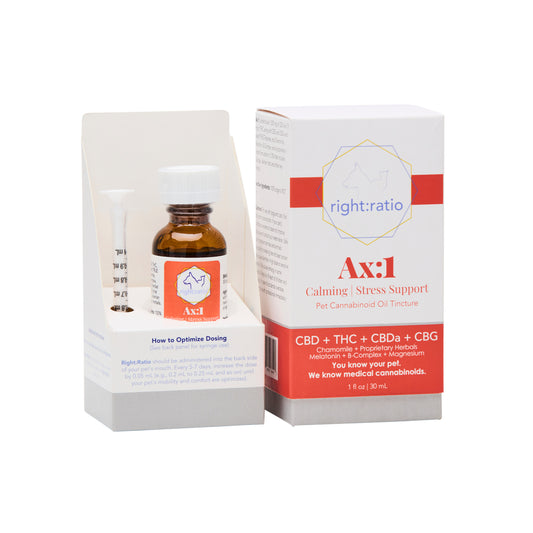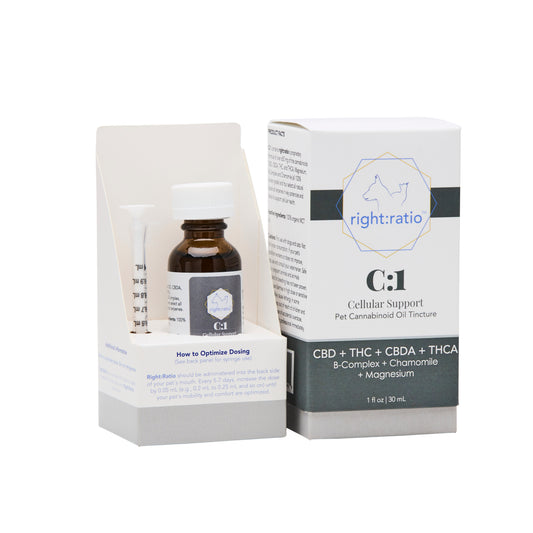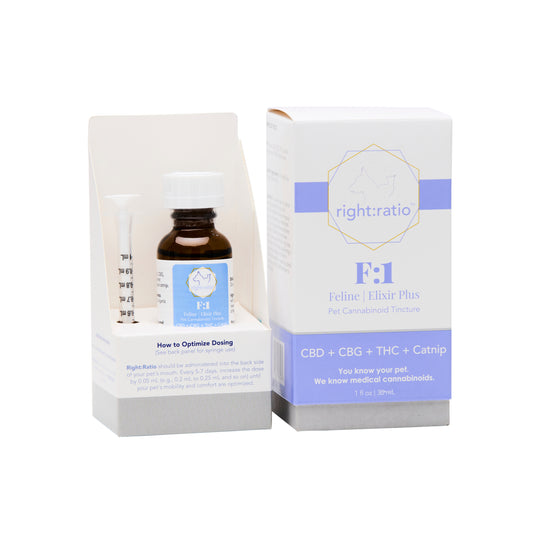Veterinary Information & Resources
Share
Thank you for visiting our resource page for veterinarians. If you are unfamiliar with basic terms associated with medical cannabinoid use in canines and felines, please click here to read up on key definitions that will help when reviewing the content below.

If you have questions about our product formulation and use of medical cannabinoids,
please call 310-600-7347 to speak with a member of our team.
What is the Endocannabinoid System (“ECS”)?
Every cat and dog, as well as virtually every other animal, has an endocannabinoid system (“ECS”). It was discovered by Dr. Raphael Mechoulam in the 1970s and has been described as a system of lipid based retrograde neurotransmitters and receptors occurring throughout the CNS and PNS that promotes homeostasis or balance of the body.

Parts of the ECS
The ECS is composed of three essential parts:
-
Receptors: The endocannabinoid receptors at CB1 is the most abundant protein-based receptor found in the human brain and central nervous system. The CB2 receptors are found mostly in the spleen and immune system.
-
Endocannabinoids: Endogenous endocannabinoids* are produced within the ECS such as Anandamide/AEA which is the primary endogenous ligand for CB1 receptor and 2-AG, the primary endogenous ligand for CB2 receptor. These chemicals are created on demand and due to their lipid-based chemical structure bind to nearby CB receptors and then are degraded immediately. *(link this term to the heading below)
- Regulatory Enzymes: including FAAH, which degrades anandamide, MAGL that degrades 2-AG and COX-2 enzymes that degrades both Anandamide and 2-AG.
Functions of the ECS
The ECS functions in neuromodulation and the endocannabinoids are generated on demand by the body, especially in times of stress, disease or injury. Key functions of the ECS are as follows:
- Alterations of physiologic function and behavior
- Affects both cognitive and physiological processes
- Promotes homeostasis
The ECS also interacts with phytocannabinoids, which are compounds derived from plants such as marijuana and hemp, when they are introduced into the pet’s system.
What are Cannabinoids and Their Effects?
Cannabinoids refers to the group of chemical messengers that exist in two different forms: endogenous or exogenous, such as compounds derived from the plant itself.
Exogenous Cannabinoids also known as Phytocannabinoids :
Phytocannabinoids (such as CBD and THC for example) are chemical compounds derived from either hemp or marijuana, which are both subspecies of the genus Cannabis Sativa (not to be confused with common parlance of strains of marijuana, such as sativa or indica). There are over 120 of these compounds within the cannabis plant, and over 700 total compounds including terpenes and flavonoids.

Key Cannabinoids and their Effects
1. Cannabidiol (CBD): is an antagonist, with low binding affinity at CB1 and CB2 receptors. CBD is unique in that it has been shown to inhibit FAAH in mice, which can allow anandamide (or THC) to act on the receptors longer. Some of the most well-known physiologic effects of CBD include:
- Anti-inflammatory
- Anxiolytic/Anti-depressant
- Anti-neoplastic
- Analgesia
- Cardioprotective
- Neuroprotective and Anti-convulsant
2. Δ9-tetrahydrocannabinol (THC) is a partial agonist for both CB1 and CB2 and is largely responsible for the neurological effects noted with cannabis use. Some of the most notable physiologic effects of THC include:
- Analgesia
- Anti-neoplastic
- Appetite stimulant/Anti-emetic (works peripherally and centrally)
- Anti-inflammatory
- Promotes sleep
3. THCa and CBDa: These compounds are found in the raw plant with THCa being the most common cannabinoid found in marijuana and CBDa being the most common cannabinoid found in the hemp plant. These molecules are less studied than CBD and THC but emerging data indicates that the acids (CBDa and THCa) have significant potential physiologic and therapeutic effect.
Some of the physiologic effects of THCa and CBDa include:
- Anti-emetic
- Anticonvulsant
- Anti-inflammatory (COX-2 Inhibition)
- Anti-neoplastic
These acids precursors (e.g., CBDa converts to CBD and THCa converts THC when exposed to heat) must be stored and handled carefully to prevent rapid conversion to their neutrals, especially in the case of THCa which, upon conversion, would add THC and potential psychoactivity to an otherwise non-psychoactive product.
What are Terpenes?
Terpenes are volatile unsaturated hydrocarbons found in the essential oils of plants, including cannabis and hemp, that give the plant aromatic qualities and possess medicinal properties. While there are approximately 200 terpenes, the most researched ones are beta-caryophyllene, myrcene, limonene, linalool, alpha-pinene and humulene.
Terpenes have synergistic effects with cannabinoids and can greatly impact the body. Some increase the absorptions of cannabinoids and some terpenes act on the ECS directly (i.e beta-caryophyllene o CB2 receptors).

Cannabinoids, Terpenes and the Entourage Effect
The Entourage Effect describes the importance of whole plant-based medicine. It describes the quantity and distribution of major and minor cannabinoids, terpenes, and flavonoids in the cannabis plant that affects the degree of biological activity and the spectrum of diseases treated. The millions of unique combinations of these compounds have led to the study of specific phenotypes and chemotypes to treat specific medical condition.
The Entourage Effect suggests the following when selecting cannabinoid products in veterinary medicine:
- Isolated compounds or molecules often don’t demonstrate medical efficacy as well as whole plant extracts
- Highly processed molecules such as CBD isolate (e.g., 99% or more pure CBD) can be less efficacious than lower potency CBD that has retained the natural terpenes and other compounds, such as flavonoids, through the extraction process
Right:Ratio custom tinctures deploy all major cannabinoids as well as trace amounts of CBN and CBG, select potencies and ratios of 100% natural terpenes and herbals to provide three agencies for medical applications, all predicated on whole plant/entourage principles
Potential Side Effects and Contraindications of Cannabinoids
Side Effects: THC
The principle side effect of Δ9-tetrahydrocannabinol (THC, but not THCa) is psychoactivity or dysphoria in canines and felines. As a result, in any formulation of cannabinoids, THC is always the limiting or baseline factor for pet safety.
Interestingly, there is no LD50 in dogs for THC (>3000 mg/kg THC). This is markedly different than most if not all manufactured pharmaceutical prescription and OTC products used for pets.
Dogs in particular have higher amounts of CB1 receptors in their cerebellum compared to any other species. When they receive excessive amounts of THC (either via accidental ingestion or overdose) they develop a unique toxicity known as Static Ataxia. Dogs with this condition frequently present with severe ataxia and a sawhorse stance.
Excessive THC exposure in dogs and cats can also result in:
- Urinary incontinence
- Severe lethargy
- Agitation
- Changes in heart rate
- Hypersalivation
The majority of dogs experiencing intoxication after THC ingestion recover completely with supportive care and monitoring. Dogs with severe clinical signs may require the use of intravenous fluids.
Side Effects: CBD
CBD has very few side effects in both humans and veterinary patients. A recent study found that CBD was found to be well tolerated in dogs at a dose of 10-20 mg/kg/day. This is significantly higher then the typical concentrations found in most products. The only hematological effect is an elevation in serum ALP, which may be related to cholestasis but the exact cause is unknown. Other side effects include mild gastrointestinal signs (diarrhea) and mild sedation.
Contraindications
Cannabis is a vasodilator and, as such, can result in tachycardia. In older pets and pets with any cardiovascular disease, caution must be used in formulating THC and CBD potencies and ratios to reduce instances of tachycardia.
Cannabis products for pets that are properly calibrated for the breed, age and comorbidities of the pet can often be used safely along with most pharmaceutical products. However, caution must be used when cannabis extracts are used with these medications:
- Blood thinners including Warfarin
- Theophylline
- Antidepressants
- Sedatives





